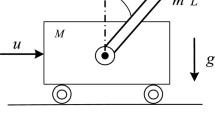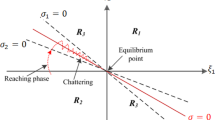Abstract
This paper develops tracking control of quadrotor unmanned air vehicle in the presence of parametric uncertainties and mismatched exogenous disturbances. First, a traditional sliding mode control (SMC) law is synthesized for a nominal model without parametric uncertainties and disturbances to achieve nominal control performance. Then to compensate the system uncertainties existing in the actual system, gain-scheduling based SMC law is synthesized. However, the gained scheduled SMC does not provide better control performance in the presence of unknown exogenous disturbances existing in actual system. To end this, a novel nonlinear disturbance observer is integrated with gain scheduled SMC to counteract the exogenous disturbances and attain the performance of reference nominal model. The proposed nonlinear disturbance observer SMC method exhibits the following two salient characteristics: first, the design gains should be greater than the bound of disturbance estimation error rather than that of disturbances, second; in the absence of uncertainties the nominal control performance of sliding mode control strategy is retained. The stability analysis of the proposed control strategy is validated using Lyapunov theorem. Finally, numerical simulation results are exhibited to illustrate the efficacy of the proposed control strategy.











Similar content being viewed by others
References
Yuhu Du, Fang J, Miao C (2013) Frequency-domain system identification of an unmanned helicopter based on an adaptive genetic algorithm. IEEE Trans Ind Electron 61(2):870–881
Murphy DW, Cycon J (1999) Applications for mini VTOL UAV for law enforcement. Proc SPIE Sens C3I Inf Train Technol Law Enforce 3577:35–43
Slater G (2003) Cooperation between UAVs in a search and destroy mission. In: AIAA guidance, navigation, and control conf. and exhibit, Austin, Texas, USA
Herwitz SR, Johnson LF, Dunagan SE, Higgins RG, Sullivan DV, Zheng J, Lobitz BM, Leung JG, Gallmeyer BA, Aoyagi M, Slye RE, Brass JA (2004) Imaging from an unmanned aerial vehicle: agricultural surveillance and decision support. Comput Electron Agric 44(1):49–61
Kim JH, Sukkarieh S (2003) Airborne simultaneous localisation and map building. Proc IEEE Int Conf Robot Automat Taipei Taiwan China 1:406–411
Sarris Z (2001) Survey of UAV applications in civil markets. In: Proc the 9th mediterranean conf. control and automation, Dubrovnik, Croatia
Zhong Y, Zhang Y, Zhang W, Zuo J, Zhan H (2018) Robust actuator fault detection and diagnosis for a quadrotor UAV with external disturbances. IEEE Access 6:48169–48180
Bouabdallah S, Siegwart R (2007) Full control of a quadrotor. In: IEEE/RSJ international conference on intelligent robots and systems, IEEE, pp 153–158
Erginer B, Altug E (2007) Modeling and PD control of a quadrotor VTOL vehicle. In: 2007 IEEE intelligent vehicles symposium. IEEE, pp 894–899
Kim GB, Nguyen TK, Budiyono A, Park JK, Yoon KJ, Shin J (2013) Design and development of a class of rotorcraft-based UAV. Int J Adv Robot Syst 10(2):131
Bolandi H, Rezaei M, Mohsenipour R, Nemati H, Smailzadeh SM (2013) Attitude control of a quadrotor with optimized PID controller. Intell Control Automat 4(03):335
Patel AR, Patel MA, Vyas DR (2012) Modeling and analysis of quadrotor using sliding mode control. In: Proceedings of the 2012 44th southeastern symposium on system theory (SSST). IEEE, pp 111–114
Choi HH (2007) LMI-based sliding surface design for integral sliding mode control of mismatched uncertain systems. IEEE Trans Automat Control 52(4):736–742
Huang YJ, Kuo T-C, Chang S-H (2008) Adaptive sliding mode control for nonlinear systems with uncertain parameters. IEEE Trans Syst Man Cybern B Cybern 38(2):534–539
Madani T, Benallegue A (2006) Backstepping sliding mode control applied to a miniature quadrotor flying robot. In: IECON 2006—32nd annual conference on IEEE industrial electronics, IEEE, pp 700–705
Utkin V, Shi J (1996) Integral sliding mode in systems operating under uncertainty conditions. Proc 35th IEEE Conf Decis Control IEEE 4:4591–4596
Cao W-J, Jian-Xin Xu (2004) Nonlinear integral-type sliding surface for both matched and unmatched uncertain systems. IEEE Trans Automat Control 49(8):1355–1360
Zheng E-H, Xiong J-J, Luo J-L (2014) Second order sliding mode control for a quadrotor UAV. ISA Trans 53(4):1350–1356
Wen C-C, Cheng C-C (2008) Design of sliding surface for mismatched uncertain systems to achieve asymptotical stability. J Franklin Inst 345(8):926–941
Mofid O, Mobayen S (2018) Adaptive sliding mode control for finite-time stability of quad-rotor UAVs with parametric uncertainties. ISA Trans 72:1–14
Dou J, Tang Q, Zhou L, Wen B (2017) An adaptive sliding mode controller based on global asymptotic convergent observer for attitude tracking of quadrotor unmanned aerial vehicles. Adv Mech Eng 9:1687814017723295
Ahmed N, Chen M (2018) Sliding mode control for quadrotor with disturbance observer. Adv Mech Eng 7:1687814018782330
Allahverdy D, Fakharian A, Menhaj MB (2019) Back-stepping integral sliding mode control with iterative learning control algorithm for quadrotor UAVs. J Electr Eng Technol 14(6):2539–2547
Barmish BR, Leitmann G (1982) On ultimate boundedness control of uncertain systems in the absence of matching condition. IEEE Trans Autom Control AC-27(1):153–158
Ali N, Alam W, Rehman AU, Pervaiz M (2017) State and disturbance observer based control for a class of linear uncertain systems. In: 2017 international conference on frontiers of information technology (FIT) IEEE, pp 139–143
Chen W-H (2003) Nonlinear disturbance observer-enhanced dynamic inversion control of missiles. J Guid Control Dyn 26(1):161–166
Xinghuo Yu, Kaynak O (2009) Sliding-mode control with soft computing: a survey. IEEE Trans Ind Electron 56(9):3275–3285
Luukkonen T (2011) Modelling and control of quadcopter. Independent research project in applied mathematics. Mat-2.4108, Aalto University School of Science, Espoo, 22 August 2011
Austin R (2010) Unmanned aircraft systems: UAVs design, development and deployment. Wiley, London
Ali N, Rehman AU, Alam W, Maqsood H (2019) Disturbance observer based robust sliding mode control of permanent magnet synchronous motor. J Electr Eng Technol 14(6):2531–2538
Author information
Authors and Affiliations
Corresponding author
Additional information
Publisher's Note
Springer Nature remains neutral with regard to jurisdictional claims in published maps and institutional affiliations.
Rights and permissions
About this article
Cite this article
Maqsood, H., Qu, Y. Nonlinear Disturbance Observer Based Sliding Mode Control of Quadrotor Helicopter. J. Electr. Eng. Technol. 15, 1453–1461 (2020). https://doi.org/10.1007/s42835-020-00421-w
Received:
Revised:
Accepted:
Published:
Issue Date:
DOI: https://doi.org/10.1007/s42835-020-00421-w




